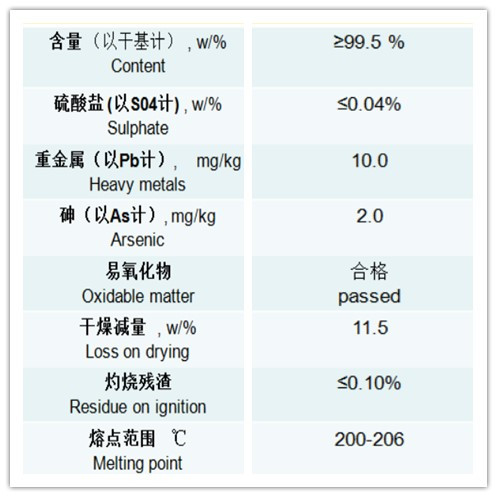DL-Tartaric Acid
Molecular formula: C4H6O6
Molecular weight: 150.09
Properties: colorless crystalline or white crystalline powder, odorless and sour. It is a mixture of equal amounts of right-handed and left-handed tartaric acid, often containing one or two crystalline water, which will be lost when heated to 100 º C. It is stable in air with a density of 1.697. Its solubility in water is 20.6 (20 º C), about 1% in ether and 5.01 (25 º C) in ethanol.
Specification: in accordance with American food chemical code (IV) and gb15358-94.
Usage: This product is widely used in food, medicine, chemical industry, light industry, and other industries. For example, as a beer foaming agent, food sour agent, flavoring agent, used in cool drinks, candy, fruit juice, sauce, cold dish fermentation powder, its sour taste is 1.3 times that of lemon, especially suitable for the sour taste of grape juice. It also plays a very important role in tanning, photography, glass, enamel, telecommunications equipment and other industries. This product has been identified as an excellent food additive by FAO / WHO Expert Committee.
Packaging: 25kg composite paper bag, lined with polyethylene bag.

DL-Tartaric Acid is colorless crystal or white crystal powder, odorless and sour. It is a mixture of equal amounts of right-handed and left-handed tartaric acid, often containing one or two crystal water, heated to 100 ℃ ° It is soluble in water and insoluble in chloroform. DL tartaric acid can be used as sour taste agent, chelating agent, antioxidant synergist, aroma enhancer, quick acting leavening agent, acid substance, food pigment diluent and solidifying agent. DL-Tartaric Acid is widely used in food, medicine, chemical industry, light industry and other industries. It is mainly used in the manufacture of tartrate. In the food industry, it is used as beer foaming agent, food sour agent, taste corrector and sour agent of grape juice. It is also used in tanning, photography, glass, enamel, telecommunication equipment, etc.
IUPAC
2,3-dihydroxybutanedioic acid
SMILES
C(C(C(=O)O)O)(C(=O)O)O



















